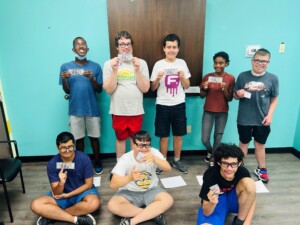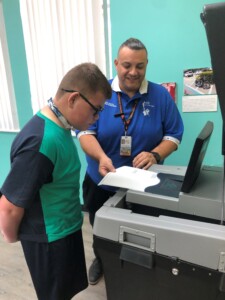By Matthew Louis LaGassa Published May 1, 2023
Reviewed by Victoria Wells
All About Service Animals
If you’ve spent any time in the past couple of years in public spaces, or even some offices, then chances are, you’ve seen an animal, usually a dog, in a vest with some variation of “do not pet” emblazoned on it. Though service animals are neither brand new nor uncommon in today’s society, knowledge of their history, rights, and behaviors, is not as widespread as it should be. In this article, we at the Center for Independent Living in Central Florida (CIL) will endeavor to shine some much-needed light on these vital animals’ history, rights, how to get one, how to properly behave around them, and even discuss their contemporaries in similar fields, like therapy animals. These animals can serve by identifying allergies, alerting to oncoming seizures or drops in blood sugar for diabetic individuals, de-escalating symptoms of PTSD and Anxiety disorders, recognizing and responding to their owner’s disassociating by leading them to safety, retrieving and reminding you to take medicine, and seeing or hearing for a person.
Their History:
Though service animals, specifically dogs, have appeared in some form in earlier American history, with “seeing eye dogs or dog guides for people with visual disabilities,” having legal protections as far back as the late 1920s, service animals as we commonly know them did not receive legal recognition until the passing of the Americans with Disabilities Act (ADA), in 1990 (Access Press Staff, 2019). The ADA now defines them as “any dog that is individually trained to do work or perform tasks for the benefit of an individual with a disability, including a physical, sensory, psychiatric, intellectual, or other mental disability” (Access Press Staff; “Service Animals,” n.d.). With the exception of miniature horses “that have been individually trained to do work or perform tasks for people with disabilities,” via their own provisions in the ADA, no other species of animals can be considered service animals (Access Press Staff).
Their Colleagues:
Though only dogs and miniature horses can qualify as service animals, felines, reptiles, and many other species can qualify for similar roles: emotional support animals, comfort animals, and therapy animals. Emotional Support Animals can provide “emotional support alleviating one or more symptoms or effects of a person’s disability,” and may even “help with depression, anxiety, and certain phobias,” but do not receive special training for “tasks that assist people with disabilities” (ADA National Network, n.d.). Comfort Animals, on the other hand, “offer a calming distraction to those impacted in an active disaster or emergency,” (ADA National Network). Finally, Therapy Animals “provide people with healing contact… to improve their physical, social, emotional, or cognitive functioning,” but neither they nor Comfort Animals are “trained to perform a specific task for an individual with a disability (ADA National Network). Despite these differences in function, these distinct groups, alongside Service Animals, all have their places in society, and enjoy rights that enable people to function at their best, regardless of location.
Their Rights and Training
As decreed by the ADA, “state and local governments, public accommodations, and commercial facilities… allow service animals to accompany individuals with disabilities in all areas where members of the public are allowed to go” (Florida, n.d.). Exact specifications of how they are allowed vary between locations, but are all upheld by either the ADA itself, or other laws. If you or someone you know with a disability needs a Service Animal, “There are organizations who help pair a service dog with a disabled handler, and the training process takes time, substantial financial investment, and patience” (NSAR, 2022). The Service Animal-to be is first trained in “basic manners… [through] thorough socialization, impulse control and the specialized skills required to support their handler [, which continues into later stages of the process]” (NSAR). This initial stage of training concludes with the dog “passing the Public Access test and Canine Good Citizen Test, which assesses the capability of the dog to be a proper, unobtrusive helpmate in public,” (NSAR). Following this test, the dog and their prospective handler are then matched, and begin training together, “to be a working team,” with the work that this phase entails going “well beyond what usually occurs in pet dog training” (NSAR). Following training, while States cannot require Service Animals be registered, the handler can register their dog through registries like Service Dog Certifications for certain benefits, like “identifiers like a service dog identification card, tags, or vests to clearly signal their dog is an assistance animal to avoid unnecessary confrontations” (Servicedog, 2023).
Proper Conduct Around Service Animals:
Some good rules of thumb are to give the animal and their handler space, and not to pet the dog without permission from the handler. Even if a service animal is not in their vest, that should not be taken as an assumption that they are off duty; trust the handler when they say if their service animal’s on duty or not, and if anything you do directed towards one, whether it be petting them, taking pictures of them, etc., is considered too invasive of the animal’s space, stop and step back. As suggested by Jacquie Brennan and Vinh Nguyen (2023) giving the service animal and handler space is also a viable strategy if you are either allergic to or afraid of dogs: “Allergies and fear of dogs are not valid reasons for denying access or refusing service to people using service animals.” This all may not sound revolutionary to you, especially when you likely exhibit similar behavior around animals in general, but considering the importance of service animals, and the possible penalties one may face for obstructing them, it is worth mentioning.
Reviewing Their Importance:
For as long as the ADA has stood, so too have the many service animals and their handlers that have tirelessly stood as models for the equity and inclusion of all individuals with disabilities in all facets of everyday life. Next time you see one of these pairs, in or out of vest, we at the CIL hope that you remember their storied history and duties and, whether as a handler or spectator, always respect these very good dogs, and miniature horses, and their colleagues as emotional support, comfort, and therapy animals, in all that they do. As ardent supporters of the Independent Living Movement, we have always believed in the importance of community understanding and empowerment in ensuring all can live independent lives, and through these positions, we are honored to include animals in these shared empowering bonds.
References:
- Access Press Staff. (2019, January 9). HISTORY NOTE: The History of Service Dogs and the Protections They Have. Retrieved March 21, 2023, from https://mn.gov/mnddc/past/access_press/Access_Press_01-19.pdf
- Everything you need to know about service dogs. NSARCO. (2022, April 26). Retrieved March 21, 2023, from https://www.nsarco.com/everything-you-need-to-know-about-service-dogs/
- Florida, D. R. (n.d.). Service animals. Disability Rights Florida. Retrieved March 21, 2023, from https://disabilityrightsflorida.org/disability-topics/disability_topic_info/service_animals
- Service animal or emotional support animal: What’s the difference? ADA National Network. (2023, March 22). Retrieved March 21, 2023, from https://adata.org/service-animal-resource-hub/differences
- Service animals and emotional support animals. ADA National Network. (2023, March 21). Retrieved March 21, 2023, from https://adata.org/guide/service-animals-and-emotional-support-animals
- Servicedog. (2023, March 9). How can I get my dog to be a registered service dog? Service Dog Certifications. Retrieved March 30, 2023, from https://www.servicedogcertifications.org/how-to-register-service-dog/


